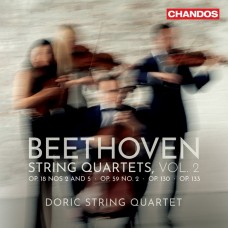|
(2CD)貝多芬: 弦樂四重奏第二集, 作品18,59,130,133
多利克弦樂四重奏
在這張貝多芬弦樂四重奏的第二集中, 多利克弦樂四重奏結合一首中期, 一首晚期和兩首早期的四重奏作品, 創造出一個自成一格的節目, 而且還是整個系列的一部份. 這些音樂家們以生動表演的作品18,第二號做開場, 接下來是作品130, 其中以貝多芬長期構思的(大賦格),作品133 (寫於1825年)當作這首的結尾. 他們還添加另一個替代版本的結尾, 是在1826年在四重奏作品130中第一次發表的部份, 因此讓聽眾們可以自行選擇其一當結尾. A大調作品18,第五號之後的是作品59,第二號. 作品18是貝多芬的第一組四重奏作品, 雖然已經過貝多芬原創藝術鑑賞力的精煉, 但其中經常顯露出仍受到海頓與莫札特的影響. 第二組四重奏,三首(拉茲莫夫斯基弦樂四重奏Razumovsky Quartets),作品59, 是在作曲家創作生涯中的黃金時期寫的(和第四號交響曲, 小提琴協奏曲和歌劇(費德里歐)同時期), 顯示出是從較早的一組發展而來, 卻又有強烈鮮明的不同. 貝多芬的晚期四重奏雖然被最初的聽眾們誤解(或是覺得無法理解), 但如今已經被廣泛推崇為西方藝術音樂的顛峰之作. 史特拉文斯基認為(大賦格)是一份絕對現代化的音樂作品, 而且永遠會是現代的.
For this second volume of Beethovens string quartets, the Doric String Quartet has combined one middle period, one late, and two early quartets to create a programme that works on its own terms, as well as forming part of the complete cycle. The musicians start off with a vivid performance of Op. 18 No. 2, following it with the Quartet, Op. 130, in which, as finale, they perform the GroBe Fugue (Op. 133), as Beethoven long contemplated it. They have appended the alternative finale, first published with Op. 130, thus allowing the listener to choose either version. Op. 18 No. 5 in A major is then followed by Op. 59 No. 2 in E minor. Op. 18, Beethovens first set of quartets, often show influences from the quartets of Haydn and Mozart, albeit very much filtered through Beethovens original artistic sensibility. The second set, the three 'Razumovsky Quartets, Op. 59, was written in a golden period of the composers creative life (alongside the Fourth Symphony, Violin Concerto, and Fidelio) and shows both development from the earlier set and a powerful distinctness. Although mis-understood (or found incomprehensible) by their first audiences, Beethovens late quartets have become universally admired as among the pinnacles of western art music. Stravinsky considered the GroBe Fuge 'an absolutely contemporary piece of music that will be contemporary forever.
CD1
LUDWIG VAN BEETHOVEN
Complete String Quartets, Volume 2
String Quartet, Op.18 No.2 (1798-99) 27:15
in G Major • in G-Dur • en sol majeur
A Son Altesse Monseigneur le Prince Regnant de Lobkowitz etc. etc.
1.I Allegro 7:41
2.II Adagio cantabile - Allegro - Tempo I 7:12
3.III Scherzo. Allegro - Trio - Scherzo da capo 4:35
4.IV Allegro molto, quasi Presto 5:31
String Quartet, Op.130 / 133 (1825) 48:30
5.I Adagio ma non troppo - Allegro - Tempo I - Allegro - 13:53
6.II Presto - L''istesso tempo - Tempo I 1:52
7.III Poco scherzoso. Andante con moto ma non troppo - Non troppo 7:14
8.IV Alla fanza tedesca. Allegro assai 2:43
9.V Cavatina. Adagio molto espressivo 7:19
10.VI GroBe Fuge, Op.133 (1825) 15:28
11.Replacement Finale, published with String Quartet, Op.130 (1826) 10:37
Total time: 84:05
CD2
String Quartet, Op.18 No.5 (1799-1800) 31:47
1.I Allegro 10:25
2.II Menuetto - Trio - Menuetto da capo 4:36
3.III Andante cantabile - 10:02
Variazione I -
Variazione II -
Variazione III -
Variazione IV -
Variaazione V -
Poco adagio
4. IV Allegro 6:43
String Quartet, Op.59 No.2 (1806) 39:58
5. I Allegro 14:27
6. II Molto adagio. Si tratta questo pezzo [con] molto di sentimento 13:07
7. III Allegretto - Maggiore (Theme russe) - 7:47
8. IV Finale. Presto - Piu presto 5:17
Total time: 72:24
Chamber: Doric String Quartet |
|



